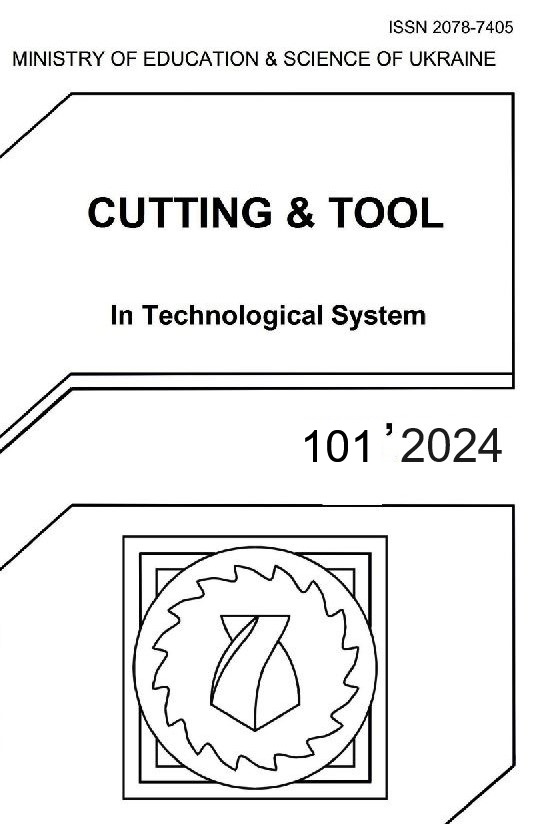DETERMINATION OF THE STABILITY PERIOD OF TURNING CUTTERS FOR HEAVY MACHINE TOOLS
DOI:
https://doi.org/10.20998/2078-7405.2024.101.09Keywords:
cutting tool, tool life, reliability, failure probability, cutting insert, cutting forceAbstract
To determine the optimal cutting modes under conditions of increased requirements for the stability of technological processes, it is necessary to take into account the value of the tool life with a given probability. In this paper, the stability dependence for prefabricated cutters used on heavy machine tools with maximum diameters Dmax = 1250-2500 mm is specified using the group argumentation method. The study presents a new mathematical model that establishes the relationship between tool fracture resistance and key operational parameters. This model incorporates the probabilistic nature of tool performance, which allows for a more accurate assessment of the impact of part size variation, cutting conditions, and process variability. The proposed relationship facilitates the determination of cutting modes that not only increase tool stability but also ensure the reliability and efficiency of heavy machine tools in industrial environments. This mathematical dependence makes it possible to take into account the variation of workpiece parameters and cutting modes, which is especially important when working with large-sized parts on heavy-duty machine tools. The results of the study are of practical importance for industry, as they make it possible to increase the sustainability and productivity of technological processes.
References
Gaddafee M., Satish S., An Experimental Investigation of Cutting Tool Reliability and its Prediction Using Weibull and Gamma Models: A Comparative Assessment, Materials Today: Proceedings, Volume 24, Part 2, 2020, pp.1478–1487, ISSN 2214-7853, https://doi.org/10.1016/j.matpr.2020.04.467
Letot, C., Serra, R., Dossevi, M. et al. Cutting tools reliability and residual life prediction from degradation indicators in turning process. Int. J. Adv. Manuf. Technol., 86, 495–506 (2016). https://doi.org/10.1007/s00170-015-8158-z
Liu, Erliang & An, Wenzhao & Xu, Zhichao & Zhang, Huiping. (2020).Experimental study of cutting-parameter and tool life reliability optimization in inconel 625 machining based on wear map approach. Journal of Manufacturing Processes. 53. рр. 34‒42. https://doi.org/10.1016/j.jmapro.2020.02.006
Karimi, B., Niaki, S.T.A., Haleh, H. et al. Reliability optimization of tools with increasing failure rates in a flexible manufacturing system. Arab J Sci Eng44, 2579‒2596 (2019). https://doi.org/10.1007/s13369-018-3309-9
Bakša, Tomáš & Kroupa, Tomáš & Hanzl, Pavel & Zetek, Miroslav. (2015). Durability of Cutting Tools during Machining of Very Hard and Solid Materials. Procedia Engineering. https://doi.org/10.1016/j.proeng.2015.01.51121
Jaydeep M. Karandikar, Ali E. Abbas, Tony L. Schmitz, Tool life prediction using Bayesian updating. Part 2: Turning tool life using a Markov Chain Monte Carlo approach, Precision Engineering, Volume 38, Issue 1, 2014, рр.18‒27, ISSN 0141-6359, https://doi.org/10.1016/j.precisioneng.2013.06.007
Karimi, B., Niaki, S.T.A., Haleh, H. et al. Reliability optimization of tools with increasing failure rates in a flexible manufacturing system. Arab. J. Sci. Eng. 44, 2579‒2596 (2019). https://doi.org/10.1007/s13369-018-3309-9
AstakhovV., The assessment of cutting tool wear, International Journal of Machine Tools and Manufacture, Volume 44, Issue 6, 2004, рр. 637‒647, ISSN 0890-6955, https://doi.org/10.1016/j.ijmachtools.2003.11.006
Zhang, G., Wang, J., To, S. (2023). Tool Fracture Wear Evaluation Method Using Cutting Chips. In: To, S., Wang, S. (eds) Fly Cutting Technology for Ultra-precision Machining. Precision Manufacturing. Springer, Singapore. https://doi.org/10.1007/978-981-99-0738-0_9
Vagnorius, Z., Rausand, M., & Sørby, K. (2010). Determining optimal replacement time for metal cutting tools. European Journal of Operational Research, 206(2), 407–416. https://doi:10.1016/J.EJOR.2010.03.023.
Rathod N., Chopra M., Vidhate U., Gurule N., Saindane U., Investigation on the turning process parameters for tool life and production time using Taguchi analysis, Materials Today: Proceedings, Volume 47, Part 17, 2021, Pages 5830-5835, ISSN 2214-7853, https://doi.org/10.1016/j.matpr.2021.04.199 .
Arif M., Rahman M., Wong Yoke San, Analytical model to determine the critical feed per edge for ductile–brittle transition in milling process of brittle materials, International Journal of Machine Tools and Manufacture, Volume 51, Issue 3, 2011, рр. 170‒181, ISSN 0890-6955, https://doi.org/10.1016/j.ijmachtools.2010.12.003
Klymenko G. Kvashnin V. Reliability assurance technological systems exploitation of heavy lathe Сutting & tool in technological system 2019; 91: рр. 78‒86 https://doi.org/10.20998/2078-7405.2019.91.08
Klymenko G., Kovalov V., Vasylchenko, Korchma D.,Boroday R. Probabilistic approach to calculating the rational thickness of the tool`s cutting insert for heavy machine tools. Сutting & tool in technological system 2023; 99: pp 110‒119 https://doi.org/10.20998/2078-7405.2023.99.1
Ravskaya N., Kovaleva L. Application of self-organisation methods for identification of processes and objects. Lucrârile ştiinţifice ale simpozionului internaţional ‘UNIVERSITARIA ROPET 2002’ - INGINERIE MECANICÂ /, Petroşani: Focus
Downloads
Published
Issue
Section
License
Copyright Notice
Authors who publish with this Collection agree to the following terms:
1. Authors retain copyright and grant the Collection right of first publication with the work simultaneously licensed under a Creative Commons Attribution License that allows others to share the work with an acknowledgement of the work's authorship and initial publication in this Collection.
2. Authors are able to enter into separate, additional contractual arrangements for the non-exclusive distribution of the Collection's published version of the work (e.g., post it to an institutional repository or publish it in a book), with an acknowledgement of its initial publication in this Collection.
3. Authors are permitted and encouraged to post their work online (e.g., in institutional repositories or on their website) prior to and during the submission process, as it can lead to productive exchanges, as well as earlier and greater citation of published work.

